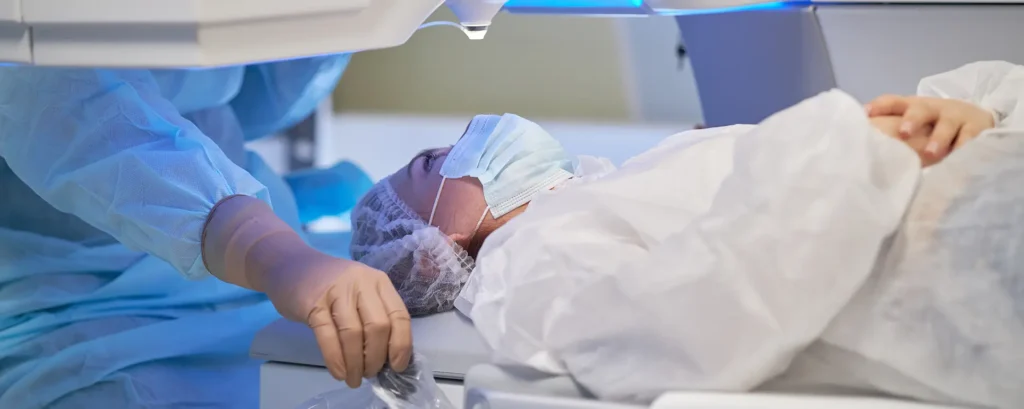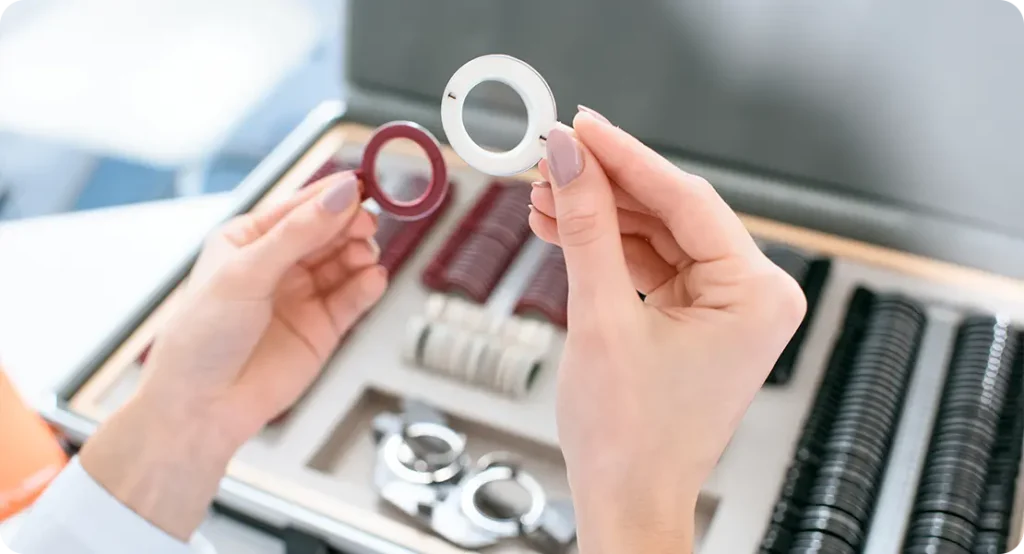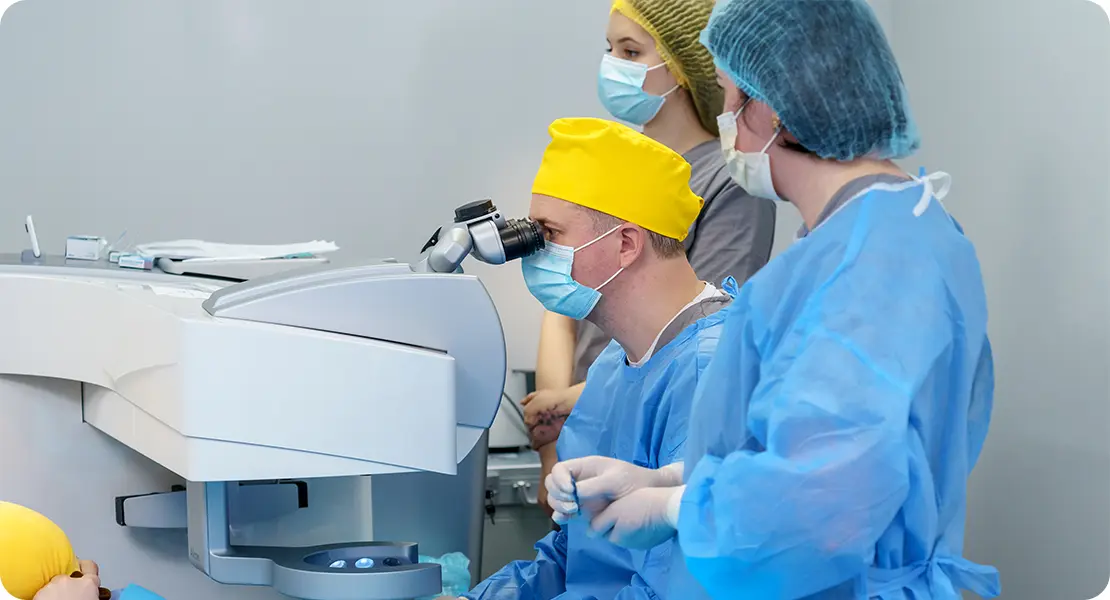If you’re a pilot who’s been told you need cataract surgery, you’re probably feeling a mix of relief and concern. Relief, because you know surgery can restore clear vision. Concern, because your career or your flying hobby depends on meeting very specific medical standards. Cataract surgery for most people is straightforward — but for pilots it comes with extra considerations. Authorities like the UK CAA (Civil Aviation Authority) and EASA (European Union Aviation Safety Agency) don’t just want to know that you can see; they need to be sure your vision is stable, safe, and reliable under every condition you might face in the cockpit.
In this guide, we’ll walk step by step through what you need to know: how the medical standards work, why your choice of lens implant matters, what documentation your Aeromedical Examiner (AME) will expect, and what timelines you can realistically plan for before getting your Class 1 or Class 2 medical back.
Why Cataracts Are a Unique Challenge for Pilots
Cataracts are an age-related clouding of the eye’s natural lens. Over time, this causes blurred vision, loss of contrast, and increased glare — all things that are particularly dangerous when flying. While many people with cataracts might delay surgery until it becomes troublesome in daily life, pilots often reach the point sooner. Even subtle changes can affect flight safety, especially at night, during instrument approaches, or when flying in poor weather.
Unlike the average patient, you don’t just need “good enough” vision for reading a newspaper. You need consistent clarity at distance, sharp contrast, and minimal sensitivity to glare or halos. A standard cataract operation might restore someone’s ability to drive, but for pilots the bar is much higher. That’s why regulators have clear guidance on what’s acceptable after intraocular lens (IOL) implantation.

The Standards: What CAA and EASA Expect After Cataract Surgery
| Requirement | Class | What’s Needed |
| Distance visual acuity | Class 1 & 2 | 6/9 or better in each eye separately; 6/6 or better in the better eye (with or without correction, depending on class). |
| Corrected vision | Both | Must be stable (no prescription changes). Residual refractive error must be minimal. |
| Colour vision | Both | Normal colour discrimination required. |
| Contrast / glare / night vision | Especially critical for Class 1 | Must not impair safety. Excessive glare/halos or reduced contrast may result in restrictions. |
| Healing / stability | Both | Refraction must be stable; no complications such as infection or untreated PCO. |
So, what exactly do the aviation medical standards require? The details vary slightly between the CAA and EASA, but the essentials are very similar.
- Visual acuity: For a Class 1 medical (commercial pilots), you’ll need distance vision of at least 6/9 in each eye separately, and 6/6 in your better eye, with or without correction. For Class 2 (private pilots), the requirement is slightly more relaxed, but still demanding.
- Correction stability: Your post-surgery refraction needs to be stable. In other words, your prescription shouldn’t be shifting week to week. Regulators want to see at least a few weeks of stability before they’ll sign you off.
- Colour vision: Cataracts can distort colour perception, and surgery generally restores it. But the AME will still check you meet the recognised standard for colour vision.
- Glare and contrast sensitivity: This is where pilots are scrutinised more than the general population. Even mild halos, glare around lights, or reduced contrast sensitivity could be unacceptable, especially for night flying.
- Lens type: Multifocal or monovision IOLs may not be acceptable because of the risk of glare and reduced contrast. Monofocal lenses targeting distance vision remain the gold standard for aviation purposes.
The big picture: regulators aren’t trying to make life difficult — they’re ensuring your eyes won’t let you down during a critical flight phase.
Lens Choice: Why It Matters So Much

The choice of IOL is perhaps the most important decision you’ll make. For the average cataract patient, lifestyle often guides the choice: some want less dependence on glasses, others prioritise reading without spectacles. For pilots, safety and compliance have to come first.
Monofocal IOLs
Monofocal lenses give sharp vision at one distance, usually set for distance vision. With these, most pilots will need glasses for near tasks, such as reading approach charts or cockpit instruments.
Why they’re preferred:
- Excellent clarity at distance.
- Minimal glare or halo risk.
- Reliable contrast sensitivity.
- Universally acceptable to regulators.
Multifocal and EDoF IOLs
Multifocal and extended depth-of-focus lenses are designed to reduce dependence on glasses. They give a range of vision by splitting or stretching focus.
The problem for pilots:
- Higher risk of glare and halos, particularly around runway lights or other bright points at night.
- Reduced contrast sensitivity compared with monofocal lenses.
- Regulators often view them with caution, especially for commercial pilots.
Monovision
This involves correcting one eye for distance and the other for near. While it can reduce glasses use, it comes at the cost of binocular depth perception and can impair performance under demanding conditions. For most pilots, monovision isn’t recommended.
The takeaway: If your priority is returning to flying safely and with minimal regulatory hurdles, monofocal lenses targeted for distance are the best choice.
Planning With Your Ophthalmologist
Before surgery, you’ll need a very clear conversation with your surgeon. Not all ophthalmologists are familiar with the specific standards pilots must meet, so it’s important you explain your profession or flying requirements.
Topics to cover:
- Target refraction: Ensure your surgeon knows distance vision is your priority.
- Astigmatism correction: If you have significant astigmatism, discuss toric lenses or other corrective steps.
- Documentation: Ask your surgeon to provide detailed pre- and post-operative reports, as your AME will require them.
- Visual side effects: Make sure your surgeon talks openly about potential glare or halos, and how likely they are with your chosen lens.
Recovery Timeline: When Can You Expect to Fly Again?
| Stage | Approximate duration | What to expect / what must be satisfied |
| Immediate rest | 1–2 weeks | Eye healing, inflammation settling, vision fluctuating. Flying not advised. |
| Refraction stabilisation | 4–6 weeks | Prescription typically settles; vision clearer but not fully stable yet. |
| Glare/night vision check | 6–8 weeks | Key period for assessing glare, halos, and contrast under low light. |
| AME evaluation | 8–12 weeks | Post-op reports complete; AME can consider medical recertification. |
| Full return | 2–3 months (longer if complications) | Most pilots cleared if all standards are met and documentation is sound. |
One of the most common questions pilots ask is “how long until I can get back in the cockpit?” The honest answer: it depends.
- First 2 weeks: Healing phase. Your eye is still inflamed, vision fluctuates, and you’re using eye drops. Flying isn’t realistic.
- Weeks 3–6: Vision usually sharpens, but your refraction may still be settling. Some pilots feel ready to fly visually in simple conditions, but regulators want to see stability before clearing you.
- Weeks 6–12: For most people, vision is stable, and post-op reports can be produced. This is the typical window for AMEs to start considering medical recertification.
- Beyond 12 weeks: If there are complications — for example, posterior capsule opacification needing YAG laser treatment — your return may be delayed.
Most pilots can realistically expect clearance between 8–12 weeks after uncomplicated surgery, provided they have monofocal lenses and no significant glare issues.
Documentation: What Your AME Will Need
Your Aeromedical Examiner isn’t just going to take your word for it. You’ll need to provide comprehensive documentation from your surgeon. This should include:
- Pre-surgery visual acuity and refraction.
- Surgical report detailing the lens type, power, and target refraction.
- Post-surgery acuity (both corrected and uncorrected), with evidence of stability.
- Colour vision testing.
- Any additional testing on glare or contrast sensitivity, if required.
- A statement confirming there are no complications.
The clearer and more complete your paperwork, the smoother your AME appointment will go.
Class 1 vs Class 2 Medicals
| Feature | Class 1 (Commercial) | Class 2 (Private) |
| Visual acuity | Stricter – typically 6/9 each eye, 6/6 better eye | Slightly less strict, but still requires good acuity |
| Glare/night vision scrutiny | High – especially for airline ops | Moderate, but still important for night flying |
| Operational exposure | Frequent night, IMC, demanding visual conditions | Often more limited exposure, depending on flying style |
| Restrictions possible | “Day only” or “no night ops” if glare/halo issues persist | Possible, but less likely unless symptoms severe |
There’s a difference between what’s required for commercial pilots (Class 1) and private pilots (Class 2).
- Class 1: Stricter standards. Distance vision must be excellent, and regulators will be more cautious about night vision and glare. If you fly for an airline, expect a longer evaluation period.
- Class 2: Standards are still high, but there’s more flexibility. Private pilots may return to flying sooner if their vision is stable and they meet the baseline requirements.
Even so, all pilots must be free from debilitating glare, halos, or contrast issues.
Practical Tips for a Smooth Return
- Don’t rush back into night flying. Even if your certificate is restored, give yourself time to adapt.
- Use quality sunglasses with anti-glare coatings for daytime flying.
- Carry reading glasses for charts and cockpit tasks if you’ve chosen monofocal distance lenses.
- Report any visual disturbances early — don’t try to “tough it out.”
- Keep all your follow-up appointments with your ophthalmologist.
FAQ: Pilots and Cataract Surgery
1. How long after cataract surgery can I expect to get my Class 1 medical back?
Most pilots can expect to be considered for recertification around 8–12 weeks after surgery, provided their vision is stable and their ophthalmologist has confirmed there are no complications. This period allows the eye to heal, for inflammation to settle, and for your prescription to stop fluctuating. For commercial pilots especially, regulators will want to see evidence of stability before granting a Class 1 certificate.
2. Are multifocal lenses acceptable for pilots under CAA and EASA rules?
Multifocal lenses are not outright banned, but they often create issues with glare, halos, and reduced contrast sensitivity — particularly problematic for night flying. Because of this, many AMEs and regulators are cautious, and pilots who choose multifocals may face extra tests or restrictions. For the smoothest path back to flying, monofocal lenses targeted for distance vision remain the preferred option.
3. Can I use monovision to reduce my need for glasses?
Monovision — where one eye is corrected for distance and the other for near — can make everyday life more convenient, but it is not ideal for aviation. It can reduce depth perception and binocular vision, both of which are critical when flying. AMEs will usually prefer both eyes set for distance to avoid problems in low-light or high-workload environments.
4. Do I need to worry about glare or halos affecting my medical clearance?
Yes, you do. Even if your visual acuity is excellent, significant glare, halos, or poor contrast sensitivity can be grounds for restrictions, especially for Class 1 pilots. Regulators may limit you to “day only” flying until these issues are shown to be acceptable. If you experience such symptoms, it’s important to raise them with your ophthalmologist and have objective tests carried out if needed.
5. What documents will my AME want to see after surgery?
Your AME will expect comprehensive reports from your ophthalmologist. These should include pre- and post-surgery vision tests, details of the lens implanted, your final prescription, evidence of stable refraction, colour vision results, and confirmation that there are no complications. The clearer your paperwork, the quicker the medical process will be.
6. What if I develop posterior capsule opacification (PCO)?
PCO is a common clouding that can occur months or years after cataract surgery. If it develops, it can blur vision or increase glare, but it is usually treated easily with a YAG laser procedure. After this treatment, your vision needs to stabilise again before you can meet medical standards. Untreated or unstable PCO will delay your clearance.
7. Will I still need to wear glasses after monofocal lens surgery?
Yes, most likely for near work. Monofocal lenses give excellent distance vision but do not correct near tasks, so you’ll probably need reading glasses for charts or cockpit instruments. This is not a problem for medical clearance, as long as your distance vision meets standards and your near vision is correctable with glasses.
8. How do regulators test for contrast sensitivity and night vision?
In many cases, standard eye chart tests are enough if you report no symptoms. However, if you complain of glare or poor night vision, your AME may ask for specialist contrast sensitivity or glare testing from an ophthalmologist. These tests provide objective data to prove your vision is safe for flight under demanding conditions.
9. Can I be restricted from night flying after surgery?
Yes, if you still experience significant glare or halos at night, your AME may apply restrictions such as “day only” until the issue is resolved or shown not to affect flight safety. Restrictions can be temporary, and many pilots find that these symptoms improve with time or treatment. The key is to demonstrate that you can fly safely in low-light conditions before restrictions are lifted.
10. Are the UK CAA and EASA requirements identical?
They are very similar, as the UK CAA continues to follow EASA-style standards post-Brexit. Both require stable vision, good acuity, and minimal glare or contrast problems. The CAA may occasionally publish its own specific guidance, but in practice, the medical requirements for pilots returning after cataract surgery are aligned with EASA rules.
Final Thoughts
Cataract surgery can restore your vision and keep you flying, but as a pilot, you face extra layers of responsibility and regulation. By choosing the right IOL — almost always a monofocal aimed at distance vision — and by ensuring your documentation is thorough, you can meet CAA and EASA standards and get back in the cockpit safely.
If you’re considering surgery, our team at London Cataract Centre can help guide you through the process, making sure both your eyesight and your flying career stay on track.
References
- Civil Aviation Authority (CAA). Guidance following eye surgery. Available at: https://www.caa.co.uk/aeromedical-examiners/medical-standards/pilots/medical-conditions/visual/guidance-following-eye-surgery/ (Accessed: 11 September 2025).
- Civil Aviation Authority (CAA). Visual System Guidance Material GM. Available at: https://www.caa.co.uk/aeromedical-examiners/medical-standards/pilots/medical-conditions/visual/visual-system-guidance-material-gm/ (Accessed: 11 September 2025).
- Civil Aviation Authority (CAA). Visual — Medical Standards for Pilots: Visual Conditions. Available at: https://www.caa.co.uk/aeromedical-examiners/medical-standards/pilots/medical-conditions/visual/ (Accessed: 11 September 2025).
- Cataract | Aviation NZ Medical Manual. Civil Aviation Authority of New Zealand. Available at: https://www.aviation.govt.nz/licensing-and-certification/medical-certification/medical-manual/part-3-clinical-aviation-medicine/ophthalmology/cataract/ (Accessed: 11 September 2025).
- Mendes, J. et al. (2025). Cataract surgery and intraocular lens implantation in … PMC. Available at: https://pmc.ncbi.nlm.nih.gov/articles/PMC11980886/ (Accessed: 11 September 2025).

